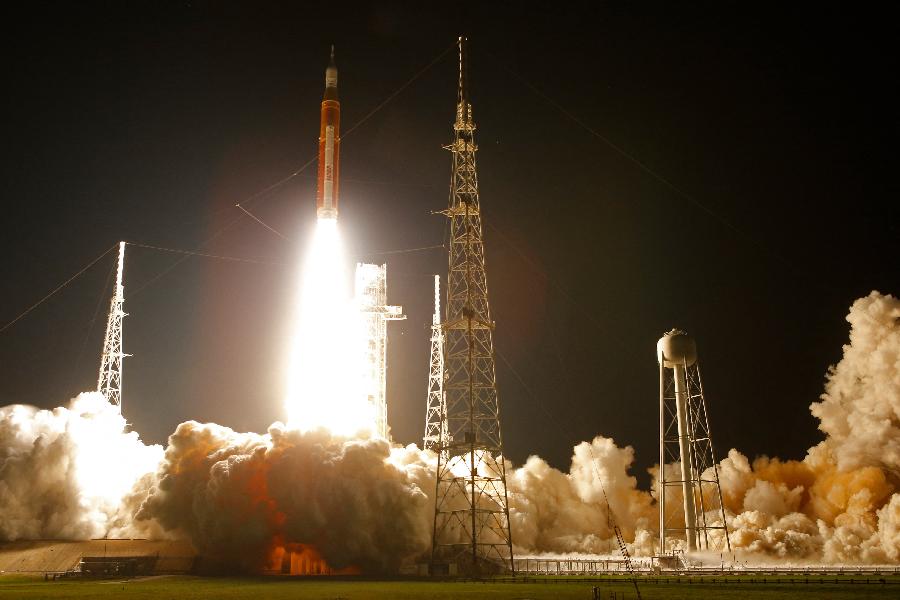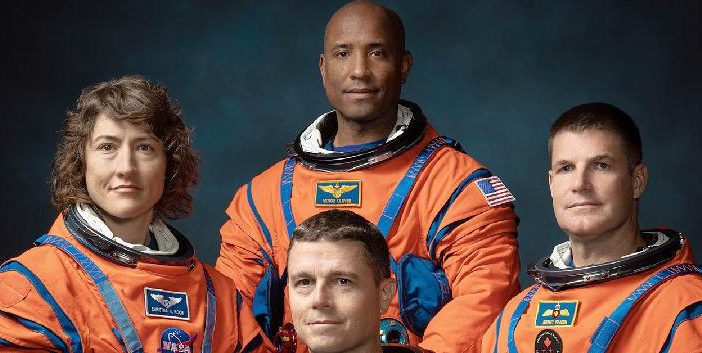Artemis II crew official portrait (Josh Valcarcel-NASA)
*(CNN) — Astronauts who will helm the first crewed moon mission in five decades were revealed on Monday, queuing up the quartet to begin training for the historic Artemis II lunar flyby that is set to take off in November 2024.
The astronauts are NASA’s Reid Wiseman, Victor Glover and Christina Koch, and Jeremy Hansen of the Canadian Space Agency.
Wiseman is a 47-year-old decorated naval aviator and test pilot who was first selected to be a NASA astronaut in 2009. He’s completed one prior spaceflight, a 165-day trip to the International Space Station that had launched aboard a Russian Soyuz rocket in 2014. Most recently, Wiseman served as chief of the astronaut office before stepping down in November 2022, making him eligible for a flight assignment.
Hansen, 47, is a fighter pilot who was selected by the Canadian Space Agency for astronaut training in 2009. He is one of only four active Canadian astronauts, and he recently became the first Canadian to be put in charge of training for a new class of NASA astronauts.
Glover is a 46-year-old naval aviator who returned to Earth from his first spaceflight in 2021 after piloting the second crewed flight of SpaceX’s Crew Dragon spacecraft and spending nearly six months aboard the International Space Station. The veteran of four spacewalks earned a master’s degree in engineering while moonlighting as a test pilot.
MORE NEWS ON EURWEB: Blac Chyna Has No Plans to Go Celibate as Part of ‘Life-Changing Journey’ | Video
 Victor Glover – Artemis II crew announcement (NASA)
Victor Glover – Artemis II crew announcement (NASA)
“It’s so much more than the four names that have been announced,” Glover said during the Monday announcement at NASA Johnson Space Center in Houston. “We need to celebrate this moment in human history. … It is the next step in the journey that will get humanity to Mars.”
Koch, 44, is a veteran of six spacewalks. She holds the record for the longest single spaceflight by a woman, with a total of 328 days in space. Koch is also an an electrical engineer who helped develop scientific instruments for multiple NASA mission. She’s also spent a year at the South Pole, an arduous stay that could well prepare her for the intensity of a moon mission.
About this mission
The Artemis II mission will build on Artemis I, an uncrewed test mission that sent NASA’s Orion capsule on a 1.4 million-mile voyage to lap the moon that concluded in December. The space agency deemed that mission a success and is still working to review all the data collected.
If all goes to plan, Artemis II will take off around November 2024. The crew members, strapped inside the Orion spacecraft, will launch atop a NASA-developed Space Launch System rocket from NASA’s Kennedy Space Center in Florida.
 NASA SLS rocket launch (Joe Skipper-Reuters)
NASA SLS rocket launch (Joe Skipper-Reuters)
The journey is expected to last about 10 days and will send the crew out beyond the moon, potentially further than any human has traveled in history, though the exact distance is yet to be determined.
The “exact distance beyond the Moon will depend on the day of liftoff and the relative distance of the Moon from the Earth at the time of the mission,” NASA spokesperson Kathryn Hambleton said via email.
After circling the moon, the spacecraft will return to Earth for a splashdown landing in the Pacific Ocean.
Artemis II is expected to pave the way for the Artemis III mission later this decade, which NASA has vowed will put the first woman and person of color on the lunar surface. It will also mark the first time humans have touched down on the moon since the Apollo program ended in 1972.
The Artemis III mission is expected to take off later this decade. But much of the technology the mission will require, including spacesuits for walking on the moon and a lunar lander to ferry the astronauts to the moon’s surface, is still in development.
NASA is targeting a 2025 launch date for Artemis III, though the space agency’s inspector general has already said delays will likely push the mission to 2026 or later.
The space agency has been seeking to return people to the moon for more than a decade. The Artemis program was designed to pave the way to establishing a permanent lunar outpost, allowing astronauts to live and work deeper into space long term as NASA and its partners map a path to sending the first humans to Mars.
The-CNN-Wire
™ & © 2023 Cable News Network, Inc., a Warner Bros. Discovery Company. All rights reserved.
We Publish News 24/7. Don’t Miss A Story. Click HERE to SUBSCRIBE to Our Newsletter Now!



